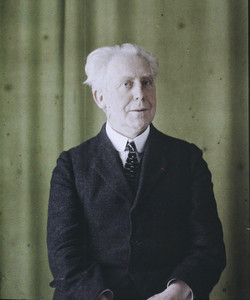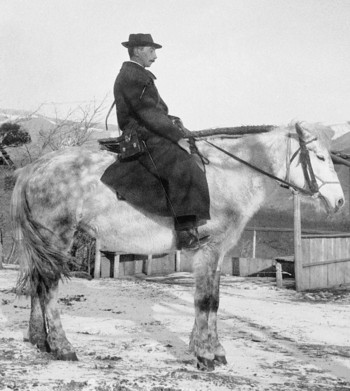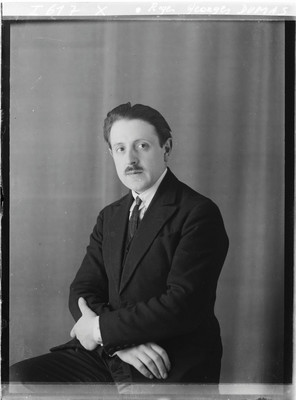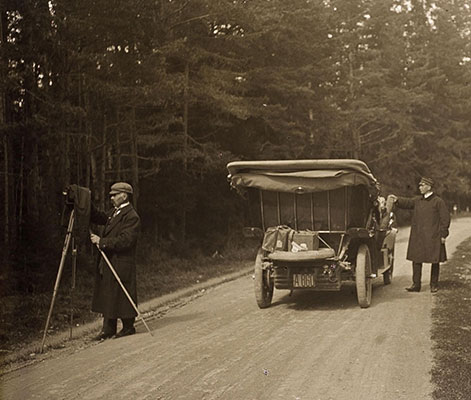A collective work
If The Archives de la Planète were a work initiated by Albert Kahn, several additional figures made it possible for him to complete this large-scale project.


First and foremost, the Lumière brothers: inventors of the two processes that materially structured the project through their complementarity – the cinema (1895) and the autochrome (1907) – they were also the first to have sent camera operators all over the world, in order to ensure the promotion of the cinematograph whose future seemed uncertain.
Next, the photographer-explorer Jules Gervais-Courtellemont, who, in 1909, definitively converted the banker to color through his autochrome screenings: excited, Kahn even imagined entrusting him in 1913 with the technical and artistic direction of his new opus.
Lastly, and for the long haul, professor Jean Brunhes (1869-1930), the project’s scientific director from 1912 until his death in 1930. This hands-on person even went on some of the missions. In parallel, Kahn financed a chair for him in human geography at the Collège de France. At that time, the geographer’s classes and conferences were one of the main uses for the projection plates.
The camera operators
In terms of the project’s backbone, there were a dozen camera operators, plus a few occasional contributors. Their presence stretches over the adventure’s twenty-odd years: the team varied from 1 to 8 people (peak reached during the war and immediate post-war period), most often oscillating between 4 and 6.

Alfred, aka Albert Dutertre (1884-1964)
He is considered as the first photography and cinematography operator who worked for Albert Kahn. Entering into the banker’s service as a mechanic-driver in November 1905, he was put in charge of the maintenance of Albert Kahn’s automobiles and taking him to his offices on the rue de Richelieu in Paris every day.
Upon his return from military service in July 1908, Albert Kahn bought him a stereoscopic photographic device and trained the young man to take pictures and develop the images. In October, Albert Kahn asked him to get ready for a long voyage and bought him another device, a film camera, a phonographic device that could record sounds, 4,000 black-and-white stereoscopic plates, several hundreds of stereoscopic autochrome plates, 3,000 meters of film and wax rollers for the sound recording. The voyage lasted from November 13, 1908 until March 11, 1909. The details of the journey were consigned to his journal. Albert Dutertre used all the glass plates and filmed several films, only the attempt to record sound failed. Upon his return from his voyage, he resumed his main activity as a driver, Albert Kahn having hired a professional photographer. He got married in 1910 and left Albert Kahn’s services shortly thereafter to move to Pont-Sainte-Maxence where he became an engineer. His brother Georges took over his position as driver in Boulogne.
Lucien Le Saint (1881-1931)
Lucien Le Saint started his career as an operator of news films and then fictional films at Gaumont. During World War I, he belonged to the The Section Photographique et Cinématographique des Armées
(Cinematographic and Photographic Section of the French Army) and stood out thanks to his aerial shots. He joined the Archives de la Planète in 1918 exclusively as a film operator until 1923 and was very prolific during this time (war-torn regions, Lebanon, Syria, Austria, Germany, Belgium, Newfoundland, France). Albert Kahn viewed his work and always seemed satisfied. In 1923, he became the news film operator for Pathé News. He also filmed, with the director Jean Grémillon, Tour au Large on Groix Island, which debuted in 1927, but, unfortunately, the end of his life was marked by blindness.

Roger Dumas (1891-1972)
Roger Dumas first worked with a frame-maker and then with a photographer where he worked as a portraitist. Perhaps it is thanks to this talent that he entered into the service of the Archives de la Planète in 1920, upon his return to civilian life.
During his first few years of collaborating on Albert Kahn’s project, he mostly worked in Boulogne, making most of the portraits of the patron’s guests and the Autour du Monde Society. In the spring of 1926, he set out on his first large mission taking autochromes and filming all over Japan for more than eighteen months.
Particularly attached to this country and wanting to do without an interpreter, he even learned the language. In 1927, he left for India on the occasion of the Maharajah of Kapurthala’s jubilee celebration, whom he had met previously at Albert Kahn’s home in Boulogne.
He brought back autochromes and films. Interested in color reproduction, he attempted to develop an industrial color cinema process and, in 1949, co-invented the Dugromacolor process, which nevertheless remained a prototype.
Frédéric Gadmer (1878-1954)
Frédéric Gadmer was born in Saint-Quentin to a protestant family originally from Switzerland. At the turn of the century, his family moved to Paris. Before World War I, he worked at a heliogravure company called Maison Vitry. During the war, he was a member of the Photographic section of the French Army and was sent to Cameroon on a mission. In 1919, at the age of 41, he was hired by Albert Kahn to be a photographer for The Archives de la Planète, probably thanks to his friends from the Section Photographique et Cinématographique des Armées, Paul Castelnau and Fernand Cuville, who had worked together. Upon his arrival, he went on missions in Syria, Lebanon, Turkey and Palestine. He went back to the Levant in 1921 with Jean Brunhes, the scientific director of The Archives de la Planète, who he also accompanied to Canada in 1926. As of 1924, following the departure of his friend Lucien Le Saint, Frédéric Gadmer also became a cinema operator. He covered Iraq, Persia, Afghanistan (with the Railroad Consulting Mission led by the engineer Michel Clemenceau). In 1930, he accompanied Father Francis Aupiais to the Kingdom of Dahomey. However, he also worked in Europe (Belgium, Switzerland, Germany) and in France (the worn-torn departments, Savoie, Paris, etc.) In 1931, he photographed and filmed Algeria, Tunisia and the Colonial Exposition in Vincennes. At the age of 54, he ended his collaboration with The Archives de la Planète, threatened by Albert Kahn’s bankruptcy, with the filming of Aristide Briand’s funeral on March 12, 1932. After he left The Archives de la Planète, he worked at the famous Yvon postcard company.

Stéphane Passet (1875-1941)
Signing up for the Army at the age of twenty, he stayed for fifteen years before moving to the Paris region. In 1912, he started working for the Archives de la Planète, even though his training in photography and cinematography still remains unclear today.
Indeed, as soon as he was hired, he worked for the Archives de la Planète in China, Mongolia, Japan, and Turkey. Between 1912 and 1913 he was in Morocco; in 1913, once again in China and Mongolia before embarking for Greece. At the end of 1913, he left for India.
During the Great War, he served in the artillery section, but still worked on the Archives de la Planète. Consequently, he photographed Paris in 1914 and several departments between 1915 and 1917. After the war, he left the Archives de la Planète for ten years. During this period, he created – at least – two 3D cinematic films: Sleeping Beauty (Parolini process) and The Damnation of Faust (process of his own invention), but stayed in contact with Jean Brunhes, the scientific director of the Archives de la Planète.
He returned to Albert Kahn’s services in 1929 and 1930, tasked with the mission of taking autochromes in France, only leaving the country in order to photograph The Hague International Conference in the Netherlands in August 1929.

Auguste Léon (1857-1942)
Working as a photographer in Bordeaux, he sold his business in 1906 and moved to Paris. He was the first professional operator recruited by Albert Kahn in 1909. His first recorded documents in the general Registry date from June 1909 (black-and-white plates of the Loire castles). In 1910, he went with Albert Kahn to Scandinavia and made a large number of autochromes and stereoscopic images.
In 1912 and 1913, he accompanied Jean Brunhes, the new director of the Archives de la Planète throughout Europe and the Balkans. He carried out missions in Egypt and France and photographed Albert Kahn’s properties in Boulogne and Cap Martin on the Côte d’Azur.
In the photography studio of the Archives de la Planète laboratory in Boulogne, he made portraits of many personalities who knew Albert Kahn. He also managed the laboratory itself as of 1919.
Auguste Léon appeared to be a reliable and high-quality technician, very loyal to Albert Kahn’s project. The images that he made while travelling convey great technical mastery. In addition, Jean Brunhes talked about Léon on several occasions as a “genuine artist.” He was the only operator who worked for The Archives de la Planète throughout the project’s twenty years of existence, without interruption. His last images date from September 9, 1930. He left the position that same year, at the age of 73.
Georges Chevalier (1882-1967)
Trained in photography by Auguste Léon in Bordeaux, the latter introduced him to the Archives de la Planète at the end of 1913. He was tasked with accompanying Jean Brunhes on screenings at the Collège de France. In 1914, he went to Berlin for a screening before the German Imperial authorities. Exempted from the war, he was with Jean Brunhes in 1916 during the screening tour in Switzerland and Spain in 1917. Made available to military authorities as a camera operator, he carried out several photographic missions in Alsace-Lorraine as well as in other departments and Paris. As of 1924, he was in charge of taking the color portraits of Albert Kahn’s guests in Boulogne. He participated in several missions abroad, in England (1924) and the Middle East (1926). After Albert Kahn went bankrupt in 1934, Georges Chevalier voluntarily continued to watch over the collection of plates and films for two years until his nomination in 1936 to conservator of the collection and head of the laboratory by the Department of the Seine, its new owner. He continued the development of a large number of autochrome plates and undertook a few more local photographic missions with his colleague Marguerite Magné de Lalonde (1937 World’s Fair, properties owned by the Department of the Seine, etc.), all the while organizing screenings of autochrome plates, including during the war. He retired at the end of 1949 and died in Boulogne, not far from his laboratory.

Paul Castelnau (1880-1944)
Paul Castelnau studied geography, while practicing photography. During World War I, he joined the Army’s geographic services, followed by the cinematographic and photographic section.
The autochrome plates that he took in the war-torn regions of northern and eastern France and Belgium were divided up between the Army and the Archives de la Planète, without there being any information, like for Fernand Cuville, on how they were shared. His collaboration in Kahn’s work did not last long since his last plates were taken in 1919 and bear witness to the reconstructions taking place in the Marne and Aisne departments.
However, Castelnau remained linked to Jean Brunhes (for his collection, he produced a geographical map of western Asia) and his daughter Mariel. He finished his geography thesis, interrupted because of the war, and chose a career in documentary cinema. He participated in the first crossing of the Sahara as a geographer and filmmaker.
Led by Georges Haardt and Louis Audoin-Dubreuil at the end of 1922-early 1923, it prepared him for the famous Black Cruise of 1924-1925. In the spring of 1926, he left on another faraway expedition and filmed Voyage à la Terre de Feu for the Geography Society, a huge success, and on which another one of Albert Kahn’s camera operators, Lucien Le Saint, worked.
Camille Sauvageot (1889-1931)
Camille Sauvageot came from, like other camera operators working on the Archives de la Planète, from the Army’s Cinematographic and Photographic Section created during World War I. He joined Albert Kahn’s project in 1919 essentially in order to film. He only brought back autochrome plates from Palestine, taken in April 1925 and the Vosges, at the end of 1927. However, he was the only person to test, in 1928-1929, the cinematographic color reproduction process called “Keller-Dorian,” named after one of its inventors, which combined lenticular film with a three-color lens for shooting and projecting. Today, there remains forty-five minutes of color film, realizing Albert Kahn’s dream of combining color and movement in order to recreate the reality of the world. After the end of the Archives de la Planète and World War II, Camille Sauvageot continued to participate in research regarding color cinematography for the Thomson company while still working as a camera operator. In 1947, he filmed the color version of Jacques Tati’s film Jour de Fête using Thomson Color waffled texture film.
